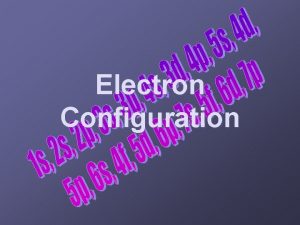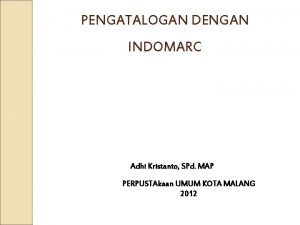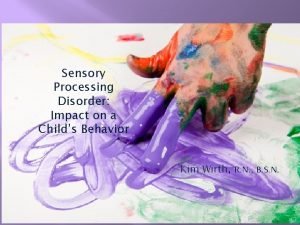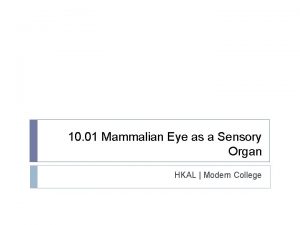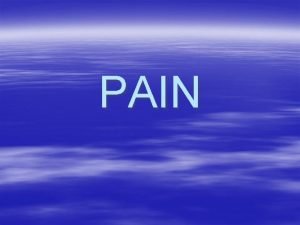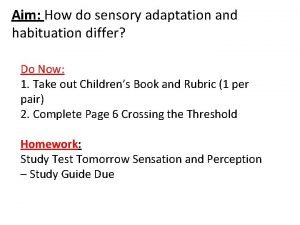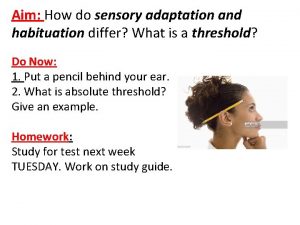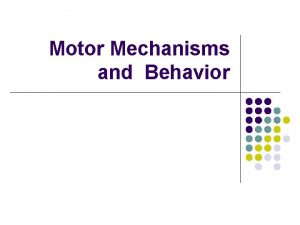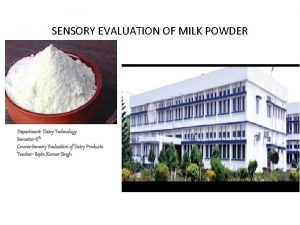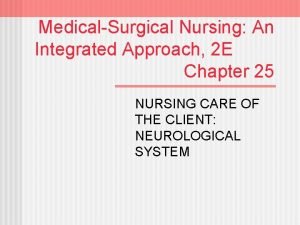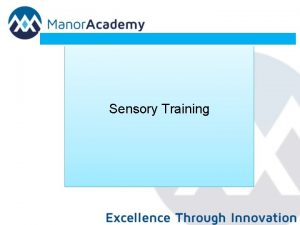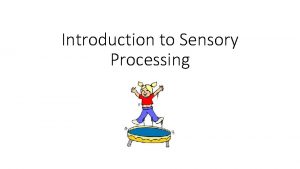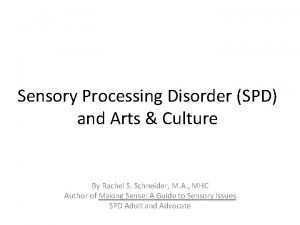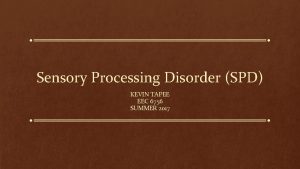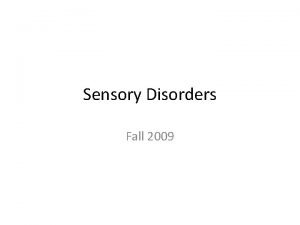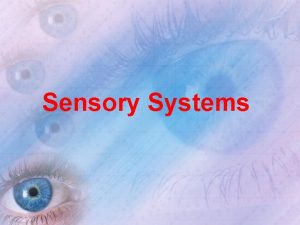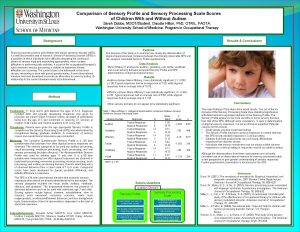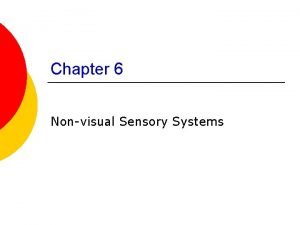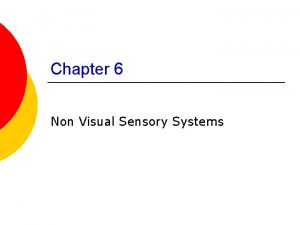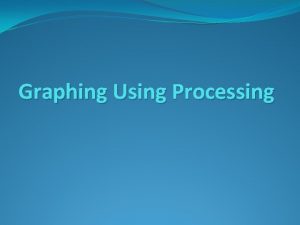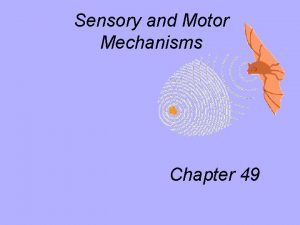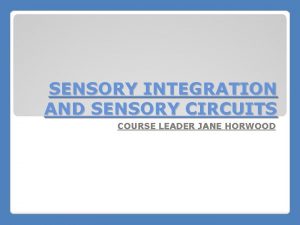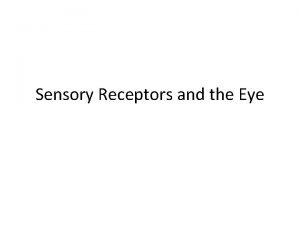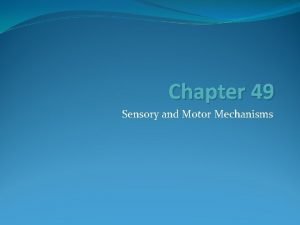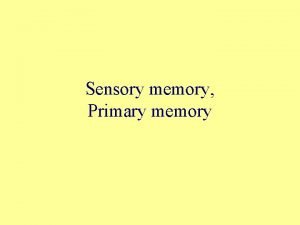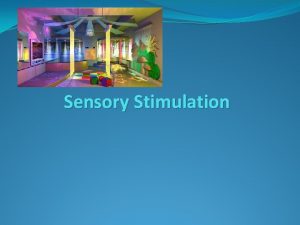Sensory Processing SPD and SI 101 Sensory Processing
































- Slides: 32

Sensory Processing, SPD, and SI 101

Sensory Processing Defined the neurological process that organizes sensation from one’s own body and the environment, thus making it possible to use the body effectively within the environment -Wikipedia 2/2014

SP allows a brain to make functional decisions based on incoming sensation 1. Visual 2. Auditory 3. Tactile 4. Olfactory 5. Gustatory 6. Vestibular 7. Proprioception *Kinesthesia 8. Interoception (See traffic light turns yellow = brake/accelerate) (Hear a siren= increase awareness for safety) (Feel food get on your face= wipe it off) (Smell soured milk = throw it out) (Taste bland food= add salt or spice) (Dive into lake at night = swim up to surface) (Type w/o looking = press correct keys) (Stand on one foot with eyes closed and balance) (Feel certain signals = use the bathroom on time) (Input is usually multi-modality rather than singular)

Dr. Winnie Dunn’s Conceptual Model of Sensory Processing

A “Neurological Threshold” refers to the amount of stimulation required for the nervous system to respond. Quick to respond , hyper-sensitive/ overresponsive= Low Threshold Slow to respond , hypo-sensitive/ underresponsive= High Threshold

A balance of sensory responsiveness is needed in order to be aware and attentive but not overwhelmed and distracted by our environment.

At the extreme ends of the neurological threshold are. . . Habituation: the process of recognizing familiar stimuli and not requiring additional attention (i. e. getting used to) and Sensitization: the process that enhances the awareness of important stimuli (i. e. desensitization refers to lessening awareness to stimuli through repeated exposure without activating fight or flight)

The ability to modulate (organize and balance) responses of the nervous system allows a person to generate an appropriate response to environmental stimuli.

Self Regulation strategies are ways people manage input available to them in order to feel calm. Passive verses active approaches to self regulate often rely upon temperament and personality.

Patterns of Sensory Processing • 4 main patterns emerged from examining a large diverse sample of people with Sensory Profile • SP Patterns are not “unitary constructs” (one dimensional) • All people fall somewhere on each continuum and patterns can change based on situation and circumstance • Persons with certain disabilities are more likely to exhibit patterns of Low Registration, Sensory Sensitivity, and Sensory Avoiding

• Sensory Sensitive (Sensor) – High Level Responsivity of the Brain (low threshold) – High Level of Habituation (Long time to react less) • Sensory Avoiding (Avoider) – High Level Responsivity of the Brain (low threshold) – Low Level of Habituation (Short time to react less) • Sensory Seeking (Seeker) – Low Level Responsivity of the Brain (high threshold) – High Level of Habituation (Long time to react less) • Sensory Registrar (Bystander) – Low Level Responsivity of the Brain (high threshold) – Low Level of Habituation (Short time to react less)

SENSORS keep track of everything! (Low thresholds + Passive self regulation) • They notice what’s going on and have precise ideas on how to handle situations • They are vigilant and particular but may come across as distractible or a complainer • When a person has sensory sensitivity patterns, interventions are directed at providing more structured input, so that the person does not become overwhelmed in everyday life.

AVOIDERS want more of the same! (Low threshold + active self regulation) • Routines keep life peaceful & manageable because change is hard • High ability to design and implement structure but may come across as inflexible • When a person has sensation avoiding patterns, interventions are directed at making input less available, so that the person does not become overwhelmed and want to withdraw from participation in everyday life.

SEEKERS always want more! • • • (High threshold + active self regulator) They enjoy and generate sensory input Active, engaging, excitable or fidgety They have high ability to generate ideas & responses They create excitement & change all around but may come across as hyper or self-centered When a person has difficulty with sensation seeking, interventions are directed at providing more opportunities for the desired sensory input within daily life activities.

BYSTANDERS don’t know what they are missing! (High threshold + passive self regulation) • Can focus in busy places, be easy going or unaffected, but miss details and social cues • May come across as dull, uninterested, apathetic, or self-absorbed • When a person has low registration patterns, interventions are directed at increasing the intensity of sensory input to improve the chances for noticing and responding to environmental demands.

Basic Tenants of Dunn’s Sensory Processing Approach • All people respond to sensory events based on own needs, experience, and genetic make up • We can characterize a person’s sensory processing patterns • Design daily life activities & environments to support sensory needs • Intervention is not intended to CHANGE the sensory processing patterns/ status • Intervention is directed at creating a better match among environments, activities and persons

Helpful Sensory Processing Assessments • Dunn’s Sensory Profile • Parham’s Sensory Processing Measure

What is Sensory Processing Disorder? SPD is when a there is a problem… Detecting, Registering, Interpreting, or Responding to stimuli (either internal, external, or both) which results in a maladaptive outcome

Proposed terminology “SPD” • The term SPD surfaced in 2007 based on the evolving treatment model of occupational therapist, researcher, author, and entrepreneur Dr. Lucy Jane Miller. LJM founded the spd foundation and directs the STAR center of Denver. • L. Miller was a student of the late great Jane Ayre’s. Dr. J. Ayre’s was the pioneer OT, educational psychologist , and neuroscientist who discovered Sensory Integration Disorder, developed three SI assessments, and the (now trademarked) Ayer’s SI approach. No other person to this day has had a more profoundly positive impact on the field of Occupational Therapy as it pertains to pediatrics • L. Miller and others “adapted” the work of Dunn and Ayre’s with a primary mission of getting SPD recognized in the latest diagnostic manual, however, it was not accepted. Controversy remains as to whether or not it is a stand alone dx. Miller’s work has also caused tensions in the SI community and general confusion in the community regarding proper use of terminology because of some of her printed statements. • The diagnosis of SPD can be used fairly synonymously with, Sensory Integration Disorder, Sensory Integration Dysfunction (SI Dysfunction) and Dysfunction in Sensory Integration (DSI) because they are rooted from the same principle theory. and all lead to essentially the same basic treatment.

LJ Miller’s Model of SPD

Helpful SPD resources: • spdfoundation (online) • Austin spd alliance (local)

Some books to consider… Dunn’s “Living Sensationally” Miller’s “Sensational Kids”

What is Sensory Integration? "The neurological process that organizes sensation from one's own body and from the environment and makes it possible to use the body effectively within the environment. " -Jane Ayres Sensory Integration and Learning Disorders, 1972 The term Sensory Integration also refers to theory, assessment, and therapy guided by the above and has been trademarked to protect the legacy of Jane Ayres.

Review of Ayre’s SI® • Sensory integration is a specialty area of occupational therapy that is based on over 50 years of theory and research. • Ayre’s SI Theory, Assessments, and Intervention are well supported • Controversy linked to poor fidelity measure and studies examining complementary techniques rather than pure Ayres SI • Ayer’s SI intervention can only be performed by qualified therapists (post graduate training USC/WPS) in clinic setting full of adequate equipment and materials • Dysfunctional patterns identified from her test (SIPT) and/or observations include: Visuo- and Somatodyspraxia, Bilateral Integration & Sequencing deficit, Vestibular dysfunction, Visual form and Space deficit, Somatosensory, Dyspraxia on Verbal Command, General SI dysfunction, Low or High Average SI and praxis, and disorders of Modulation • SI therapy is characterized by a playful atmosphere in which the child is encouraged to generate ideas for activities, to flexibly respond to novel challenges, and to develop confidence as well as competence. • Intervention includes direct & intensive services, consultation & education with caregivers, modification of environments, and inclusion of appropriate sensory-based enrichment activities throughout the day

Recommended Readings: Understanding Ayres Sensory Integration® www. pediatrictherapy. com/images/content/208. pdf Frequently Asked Questions about Ayres Sensory Integration® pathways. org/images/random_pdfs/FAQ_Ayres. pdf

Assessments for Sensory Integration • SIPT (17 standardized tests, gold standard) • Clinical Observations • Degangi-Berk Test of Sensory Integration (TSI)

Complementary Approaches (OT/Sensory)

P. Wilbarger • Patricia Wilbarger developed the brushing program and coined the phrase “sensory diet” for treatment of sensory defensiveness • She defined sensory defensiveness as the over activation of the protective sense (flight, fright, or fight reaction) • She emphasized that children with severe sensory defensiveness see certain stimulation as dangerous

Williams & Shellenberger • “How Does Your Engine Run? The Alert Program for Self-Regulation” and “Take 5” • Mary Sue Williams and Sherry Shellenberger's developed the program based on years of experience working in the schools and therapy clinics. • There focus is teaching change of arousal for improved Self-Regulation

Sheila Frick • Therapeutic Listening “Listening with the Whole Body” • Vitallinks website

Mary Kawar • Astronaut Training • Core Concepts in Action • Visual-Vestibular Connection

And much more! • • Weighted vests Compression wear Oral Regulatory Diets Minerals/supplements Vision therapy …
 S p d electron configuration
S p d electron configuration Spd bilddatenbank
Spd bilddatenbank Advanced protection technologies
Advanced protection technologies Spd 2
Spd 2 Spd map
Spd map Sensory processing disorder dsm
Sensory processing disorder dsm Types of autism spectrum disorder dsm 5
Types of autism spectrum disorder dsm 5 Sequence of sensory processing
Sequence of sensory processing High boost filtering matlab
High boost filtering matlab What is primary processing of food
What is primary processing of food Interactive processing
Interactive processing Top down vs bottom up processing
Top down vs bottom up processing Bottom up processing vs top down processing
Bottom up processing vs top down processing Bottom up and top down processing
Bottom up and top down processing Define point processing
Define point processing Histogram processing in digital image processing
Histogram processing in digital image processing Parallel processing vs concurrent processing
Parallel processing vs concurrent processing Nonlinear image processing
Nonlinear image processing پردازش تصویر
پردازش تصویر Morphological
Morphological What is top down processing
What is top down processing Wilda pain assessment
Wilda pain assessment Gait of sensory ataxia
Gait of sensory ataxia Sensory adaptation and habituation
Sensory adaptation and habituation Difference between sensory adaptation and habituation
Difference between sensory adaptation and habituation Middle cranial fossa
Middle cranial fossa Sensory and motor mechanisms
Sensory and motor mechanisms Sensory evaluation of dairy products
Sensory evaluation of dairy products Foramen interventriculare
Foramen interventriculare Cranial nerves sensory and motor
Cranial nerves sensory and motor Nervous
Nervous Motor and sensory cranial nerves
Motor and sensory cranial nerves Motor and sensory nerve
Motor and sensory nerve
